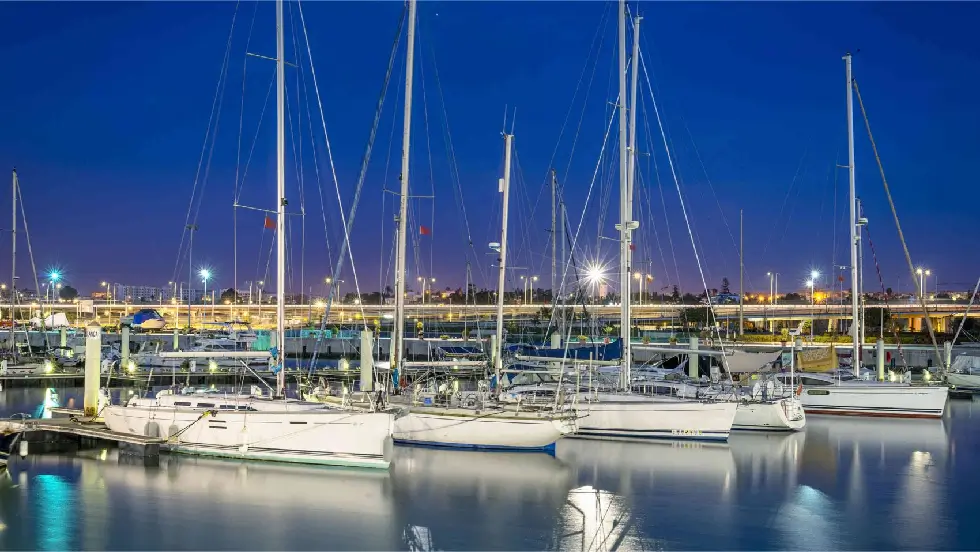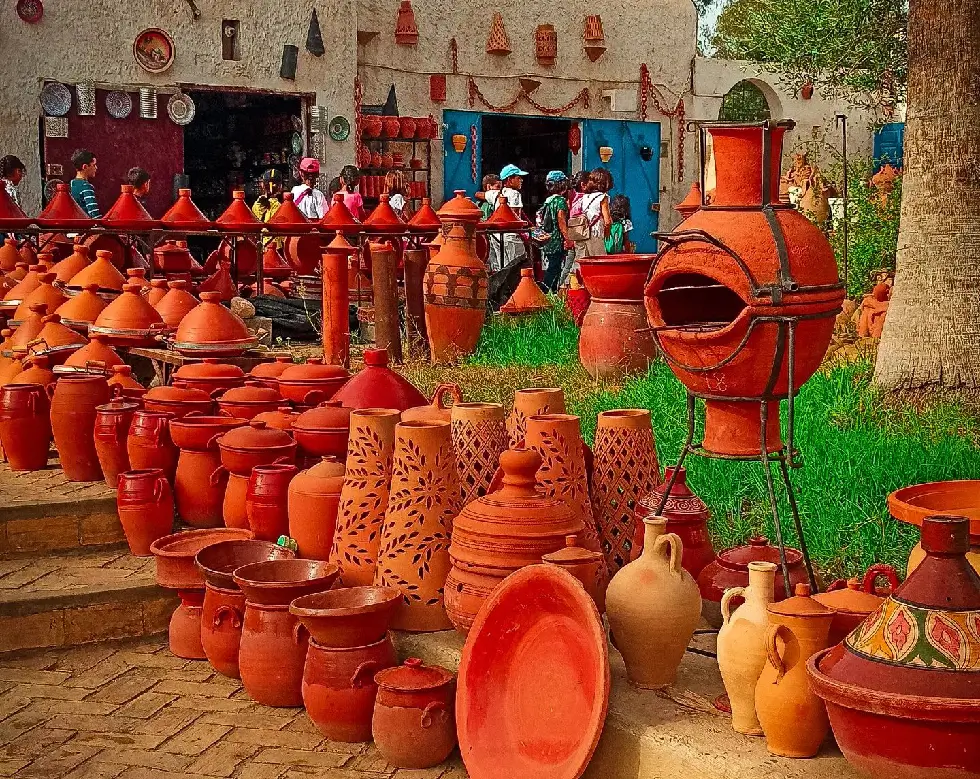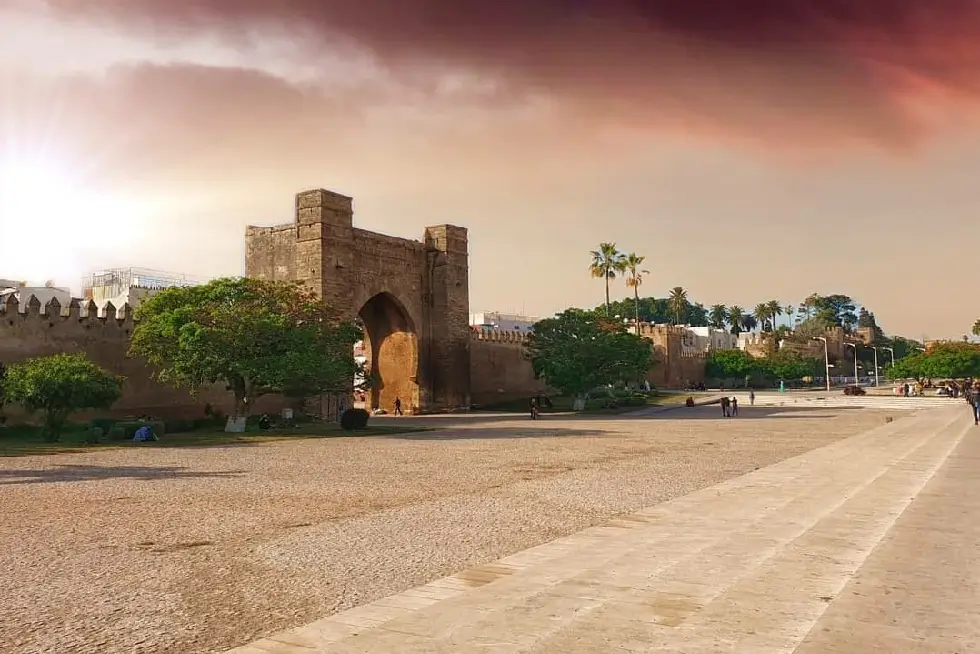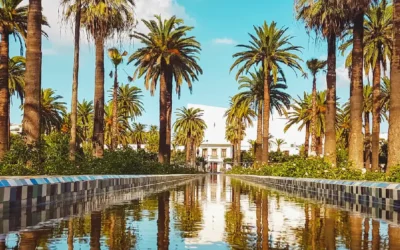Sale City, The Ancient Urban Gem of Morocco

Table of Contents:
Introduction to Salé City
Salé City, the ancient urban Gem of Morocco, known as Sale City, is a historic city located in the Rabat-Salé-Kénitra region in northwestern Morocco, with its old walled structure, poised on the right bank of the Bou Regreg River, just 3 kilometers away from the nation’s capital, Rabat.
Often seen as Rabat’s rival sister due to its distinctive cultural heritage and its ancient roots tracing back to Roman times.
With a history dating back to around 1030, founded by the Banu Ifran tribe, Salé has witnessed various pivotal phases through the centuries. It garnered notoriety in the 17th century as a haven for pirates.
Despite its rich cultural, natural, and historical assets, Salé has yet to emerge from the shadows of its illustrious neighbor, Rabat, in terms of tourist attraction.
It holds the potential to rival other tourist-centric cities of Morocco but remains an under-explored gem just 3 kilometers away from the capital.
Salé Tour Guide
Salé City, sitting next to the famous Rabat, is a doorway to exploring Morocco’s past and present, often overshadowed by its big-name neighbor. It has a rich blend of old traditions and modern vibes, making it a cool place for adventurers to explore and discover. Here are some highlights:
1. Historic Sites:
Great Mosque of Salé

It’s one of the ancient mosques around, showing off Morocco’s beautiful old-style architecture.
Madrasa of Abu al-Hasan

A breathtaking display of old Merenid design.
Zawiya of Sidi Abdallah Ben Hassoun

A place filled with spiritual and historical vibes.
2. Museums:
Belghazi Museum

Located on the way to Kenitra at Km 17, it’s a peep into the local culture and history.
Musee De l’Abeille Vivante

A fun place to learn about natural history and science.
3. Marinas and Waterfronts:
Bouregreg Marina

Where you can hire a boat and enjoy a chill ride up and down the river.
4. Shopping and Crafts:
Complexe artisanal Oulja

A cool spot to check out pottery shops and see local artists at work.
5. Traditional Markets (Souks):
Souq El Ghezel and Souq El Merzouk
Traditional markets where you can shop for local goodies and crafts.
6. Architectural Gems:
Bab Lamrissa

A beautiful building that’s also a peek into history.
7. Unique Local Experiences:
Le Quai Des Createurs

A place to discover local creativity and snag some unique souvenirs.
8. Exploration:
The city’s old part (medina) is a journey through time, with narrow streets leading to ancient markets and beautifully decorated mosques.
Accessibility And Transportation Of Salé
Salé is a city that presents a mix of both traditional and modern transit facilities, making it fairly accessible for both residents and visitors. Below are some notable features of its transportation network and accessibility:
Railway Station:
- The Salé-City railway station (Gare de Salé-Ville) stands as a significant train hub operated by ONCF (Moroccan National Railways Office) in Salé, Morocco. Being the main train station due to its high traffic volume, it also has a direct link to the Rabat–Salé tramway, facilitating easy transfers between the two cities.

National Rail Service:
- ONCF, Morocco’s national rail service, operates two primary lines linking major cities across the nation. These lines traverse through Casablanca and Rabat, offering a cost-effective and comfortable travel alternative, although they might experience occasional delays.
Road Connectivity:
- For road travel, National Route 6 provides a connection from Salé to Fez and Meknes in the east, while the N1 links it to Kénitra in the northeast, ensuring a good road network to and from Salé.
Public Transportation:

- Salé offers a range of public transportation options including buses, trams, and taxis. The Rabat-Salé Airport further extends connectivity to various destinations. From the airport, one can catch a bus to Rabat or a train to Salé, Temara, and Kenitra. The bus service, handled by Alsa City Bus, has its stop conveniently positioned right outside the terminal.

Alternative Transportation Options:
- There are multiple transportation choices like trains, buses, taxis, and personal cars. These provide a variety of price and time options, enabling individuals to pick what suits them the best. For instance, the most economical way from Morocco to Salé is by bus, with prices ranging from MAD 40 – MAD 85, whereas the fastest route takes around an hour.
The well-knit transportation network in Salé, coupled with its closeness to Rabat, ensures a relatively smooth travel experience for both the local populace and visitors.
Salé And The Modern Developments
Salé is on the rise with new infrastructure that’s set to change its cityscape. The most striking project is the Mohammed VI Tower, a massive skyscraper expected to be Africa‘s third tallest, which will include a luxury hotel, offices, apartments, and an observatory.
This development is part of a larger Moroccan government plan to spend billions on improving the country’s infrastructure over the next decade. The plan covers everything from new dams and roads to boosting tourism and port facilities.
The city’s roads are getting an upgrade too, with over a thousand miles of new roads built in recent years and more planned for the future. These roads will help support economic growth and make travel easier and quicker for everyone.
Salé’s transport links are also set to improve, with a big investment in extending Rabat’s tramway into the city. This extension will make it easier for people to get around and tie Salé’s economy closer to Rabat’s.
Overall, these developments are a big deal for Salé. They show the city is moving forward, aiming to become a modern hub that can attract businesses, tourists, and new residents, all while staying true to its historical roots.
Salé, The Economic Aspects
Over the last twenty years, Salé, the third-largest city in Morocco, has undergone remarkable economic changes. Once marked by widespread poverty and joblessness, Salé now serves as a residential hub for numerous employees from the nearby capital, Rabat, with a modern tramway linking the two cities.
The metamorphosis of Salé can be credited to the “Cities without Slums” initiative, launched in 2004, which focused on upgrading Moroccan urban centers. Contributing to Salé’s progress are policies that favor distributed local control and attract private sector investments into urban infrastructure.
These strategies are in line with Morocco’s robust economic expansion and the migration of a significant portion of its citizens to cities. The transformation of Salé is a testament to the effective implementation of urban policies, dynamic leadership, and collaborations between the government and private sector.
Salé, The Cultural And Social Identity
Salé’s identity is a rich blend of historical influences and cultural diversity. Established as a merchant hub in the 10th century, it rose to prominence with its scholarly traditions and as a base for the “Sallee Rovers” pirates.
Despite historical conflicts, including bombardments by European forces, Salé has preserved its heritage, with the tomb of its patron saint, Sīdī ʿAbd Allāh ibn Ḥasan, being a revered site. The city’s social fabric is woven from its Berber roots, with layers added by Phoenician traders, Roman rule, and Arab settlers who introduced Islam, enriching its traditions and trade relations.
French and Spanish colonization brought further complexity, infusing Salé with European cultural elements in language, education, and architecture, contributing to a multicultural society where traditional Moroccan customs coexist with colonial legacies.
This historical confluence has created a unique cultural character for Salé, mirroring the broader Moroccan experience of cultural synthesis and resilience.
Salé Historical Background
Salé’s rich past begins with its early establishment by the Phoenicians as a trading post called Sala. This city, which would later come under Roman rule, flourished as Sala Colonia on the southern banks of the Bou Regreg estuary. Around the year 1030, Salé emerged as a distinct city, founded by the Banu Ifran, an Arabic-speaking Berber tribe.

Its strategic location on the Atlantic coast soon turned it into a thriving merchant city and a significant port during medieval times. The Great Mosque, initiated by the Berbers and completed under the Almohad sultanate, still stands as a testament to Salé’s medieval prominence.
By the 17th century, Salé had transformed into a refuge for Barbary corsairs, especially the Moriscos who were expelled from Spain. These privateers, known as the “Salé Rovers,” engaged in piracy and the slave trade, leading to conflicts with European powers, including a notable French military campaign in 1629 aimed at subduing the corsair activity.
The city also played a part in the formation of the Republic of Salé, an autonomous pirate sanctuary that challenged European naval supremacy. In the decades leading to Moroccan independence, Salé became a nexus for anti-colonial sentiment and nationalistic fervor.
It was from Salé that the opposition to the “Berber Dahir” gained momentum, a decree that the locals feared would undermine Islamic law with secular Berber law. The activism in Salé was instrumental in revising this decree, exemplifying the city’s role in Morocco’s struggle for independence from French rule.
Thus, Salé stands as a city with a multifaceted historical identity, shaped by its ancient Berber roots, its time as a medieval hub, its reputation for piracy, and its part in the nationalistic movements of the 20th century. This progression mirrors Morocco’s broader historical journey toward becoming a modern nation-state with a deep and varied heritage.
Conclusion
Salé’s journey through time reflects the broader historical currents of Morocco. From its origins as a Phoenician trading center to its transformation into a Roman colony and later, a prominent medieval port city, Salé has been a witness to waves of change. It earned fame—and infamy—as a stronghold for 17th-century corsairs, resisting foreign domination while thriving on maritime exploits.
The city’s defiance in the face of colonial policies also marked it as a beacon of national resistance. Today, Salé stands as a vibrant city that celebrates its complex past, serving as a living chronicle of Morocco’s multifaceted history.
FAQ
What are some must-visit historical sites in Salé?
Visitors should not miss the Great Mosque of Salé, the Madrasa of Abu al-Hasan, the Zawiya of Sidi Abdallah Ben Hassoun, and the remnants of the city’s pirating past, including the Slave Prison. These sites offer a glimpse into the city’s layered history and architectural splendor.
What makes Salé different from Rabat?
Salé and Rabat are geographically close but historically distinct. Salé is older, with roots dating back to the Roman era, and has a legacy as an independent city with a unique cultural heritage, including its stint as a base for Barbary pirates. In contrast, Rabat has developed more as an administrative capital with a different historical trajectory, including being a protectorate capital during the French colonial period.
Why is Salé referred to as an ‘ancient urban gem’ of Morocco?
Salé earns its title as an ‘ancient urban gem’ because it embodies centuries of Moroccan history, from its Phoenician origins and Roman influences to its era as a notorious pirate haven. Despite being overshadowed by neighboring Rabat in contemporary times, Salé retains a rich cultural tapestry and historical significance that are as vibrant and alluring as any storied Moroccan city.
What is the significance of the ‘Cities without Slums’ initiative in Salé’s development?
The ‘Cities without Slums’ initiative was a transformative program launched by the Moroccan government to alleviate urban poverty by upgrading living conditions. In Salé, this resulted in improved housing and infrastructure, helping to transform the city into a more attractive and liveable area, thereby stimulating economic growth and reducing joblessness.
How accessible is Salé for tourists?
Salé is quite accessible to tourists, thanks to a combination of traditional and modern transportation, including trains, trams, buses, and taxis. Its transportation network’s integration with Rabat via the tramway and other public transit makes it easy for visitors to explore both cities conveniently.
Are there any new developments to look out for in Salé?
Yes, the construction of the Mohammed VI Tower is among the most anticipated developments, set to be Africa’s third tallest building. This skyscraper is part of a broader initiative to improve infrastructure, modernize transport links, and boost economic growth in the city.
What economic changes has Salé experienced recently?
Salé has seen a shift from a city known for poverty to a burgeoning residential and economic hub. The introduction of the tramway and urban renewal projects has bolstered its economy, with private sector investments and government policies fostering significant development and job creation.
How has Salé maintained its cultural and social identity despite modernization?
Despite modern influences, Salé preserves its identity through its historical architecture, markets, and social practices. Cultural events, traditional crafts, and local cuisine continue to thrive, with the city’s communities upholding traditions while integrating contemporary elements into their way of life.



